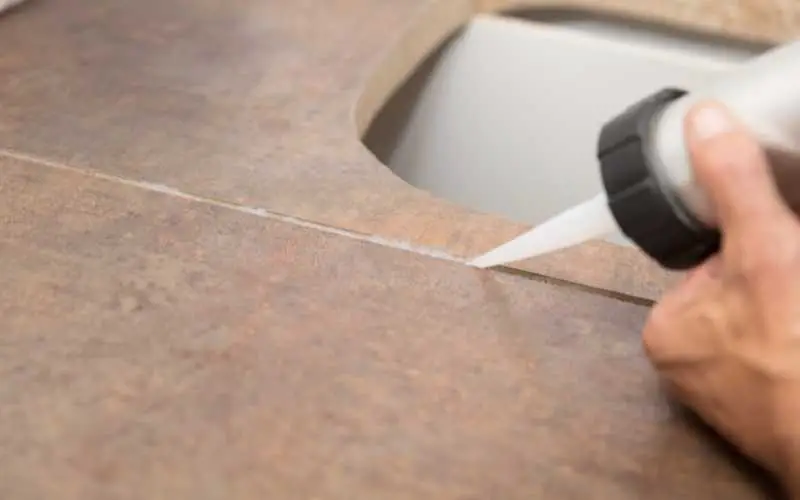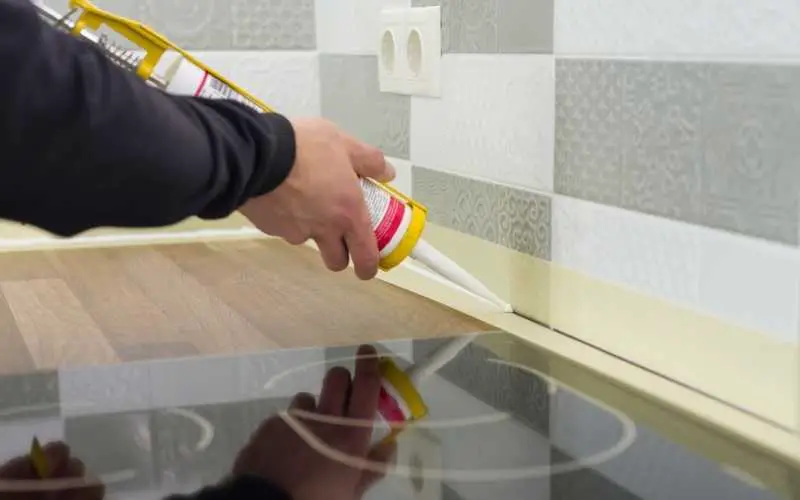Caulking is a very familiar word when it comes to masonry. You might have recently come across it, and you need to understand what it entails. Look no further; we are here for you.
Can you sand caulk? Yes, Caulk is a waterproof substance. It is usually used as a sealant and filler for cracks and holes. There are different types of Caulk, and they all perform specific and general functions.
This makes Caulk an excellent option for a filler. Some materials may be a bit more rigid but would need filling, and Caulk is a good fit for it as it is very flexible.
This flexibility makes it the best bet to seal between joints, walls, floors, and shower seams. You can use natural fibers when caulking or chemical sealants.
Related: How to Waterproof Peel and Stick Floor Tiles
Can You Sand Caulk?
Table of Contents
To answer the question on your mind, yes, Caulk can be sanded. Like everything else that will come out well, it takes attention and care.
When sanding already applied Caulk, you must take care not to destroy the surrounding surface.
You should also make sure that you’re using correct caulk smoothing tools ranging from the various types of razor blade scrapers, adhesive removers, and caulk removers.
While sanding, pay close attention to the surrounding surfaces to prevent wear. When you are done with that, don’t forget to apply a coat of primer or sealer to the corroded parts.
We’ve shown at length the meaning of Caulk and some of its uses but aren’t there more than one type of Caulk? Here are the different types of Caulk used in sealing and filling:
Types of Caulk
Pure Silicone Caulk
This is the best for bathroom work. This means all plumbing fixtures. These could include sinks, faucets, taps, or anything that tends to be close to water.
Acrylic Latex Caulk
This is one-size-fits-all Caulk, except for wet areas. It is used to fill small holes, cracks in wood trims, and joints.
Refractory Caulk
This is good for high-temperature areas like chimneys and fireplaces. The refractory Caulk can quickly fill the cracks and holes in such places.
Butyl Rubber Caulk
This particular variant is for outdoor use. From metals to masonry joints, anything that can contract and expand, butyl rubber caulk is your guy.
Polyurethane Caulk (A.K.A Masonry Repair Caulk)
Is used outdoors, but specifically for driveways and other concrete surfaces. Masonry repair caulk stands out for filling and repainting cracks in masonry-stucco walls. Polyurethane is a significant substance in making this Caulk.
Vinyl Latex Caulk
Some other caulk is softer and water-soluble, just like acrylic, but vinyl isn’t the same. It is made so that it can be applied and cleaned just as easily as Caulk used in painting.
However, when compared to acrylic latex, vinyl will last longer.
These different types have their specialties, and it is advised to use them for specific purposes. Notwithstanding, they can be used generally to fill holes
Steps to Follow to Sand Caulk
Smoothening wet Caulk starts with choosing the exact type of Caulk you need.
- Ensure the surface is clean for the job and avoid particles on the ground getting into the Caulk and getting in the way.
- Tape off the surfaces and apply the Caulk. This will prevent the surrounding surfaces from getting affected
- Get your finger wet. Rub alcohol to get silicone caulk wet, while you’ll rub water to get latex caulk wet.
- Apply slight pressure to smoothen the Caulk from one end to the other.
It is easier to smoothen wet Caulk as you see above; not many tools are needed. For dry Caulk, it is a bit more complicated.
Read: How to Install Laminate Flooring Vertically on the Wall
How to Sand Dry Caulk
Step 1
Use a utility knife to get rid of any high areas of the dried Caulk.
Step 2
To smooth it effectively, make use of coarse sandpaper.
Step 3
Position the sandpaper on the incomplete Caulk and rub firmly along the caulk line. Be careful not to rub along the adjacent sides and ruin them.
Fold the sandpaper in two, so it sits comfortably in your hand while sanding.
Is Dry Caulk Better Than Wet Caulk for Sanding?
As we’ve seen above, it is easier to smoothen wet Caulk than a dry one, obviously, but it will be disastrous for wet sand caulk.
That will defeat the entire purpose and ruin the application. Dry Caulk is ideal for sanding.
The duration for the different types of Caulk to dry will determine how soon you’ll sand the Caulk. It takes silicone and acrylic approximately 30 minutes in a well-ventilated environment (expect different results from a humid environment).
However, it needs about 1-10 days for its set and cured. After this, it’ll be good to go.
At this point, you can chip off uneven regions, smooth down rough places and be ready to paint. Will the paint be affected if you have formally applied to Caulk? Just keep reading to satisfy your curiosity.
Should You Sand Caulk Before Painting?
Caulk, like all decorating and filling supplies, comes in various forms. This makes it essential to ensure you are using the most acceptable Caulk for the job.
After sanding Acrylic caulk, you can paint it quickly; this makes it an ideal choice for interior trim such as skirting. It can be both sanded and painted.
On the other hand, pure silicone caulk is not ideal for painting after sanding. You can stick it to painted surfaces, but you cannot paint it.
If you need printable silicone caulk, it is now being manufactured and available in some stores.
The best option is to forget about painting Caulk if you intend to sand it. Or forget about sanding caulk if you intend to paint it.
This is because it would be nearly impossible to receive the primer to the surface. You can rub the Caulk with denatured alcohol instead of sanding, and that will be a win-win.
Read: How to Fill Gap between Carpet and Baseboard
Conclusion
Caulk is an essential sealant for floors, walls, and other hard surfaces that might get cracked or have holes.
Everyone is used to that perfect finish, but as we can see, not all substances can be finished so smoothly. Wet Caulk doesn’t need much to be smooth, and sandpaper is just fine for dry Caulk.
You’ll also need to note all the different types of Caulk to get the best out of them. We’re sure this article helped.
We wrote this article about can you sand caulk to help give you guidance when faced with making a choice about sanding caulk.
We hope you found it helpful and informative. If you did, please share it across your entire social media pages

